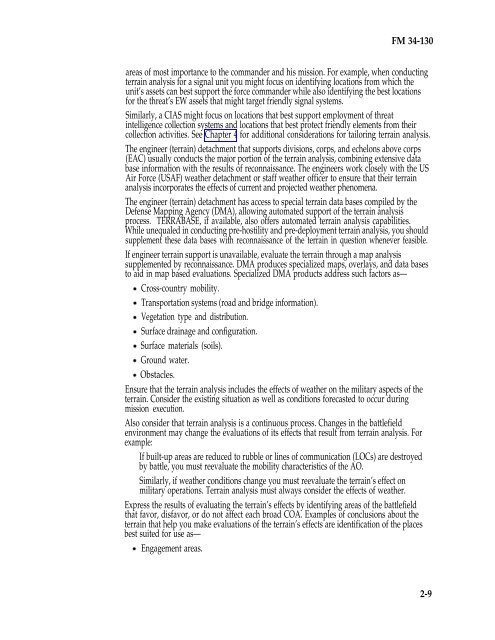Intelligence Preparation of the Battlefield - Federation of American ...
Intelligence Preparation of the Battlefield - Federation of American ...
Intelligence Preparation of the Battlefield - Federation of American ...
You also want an ePaper? Increase the reach of your titles
YUMPU automatically turns print PDFs into web optimized ePapers that Google loves.
FM 34-130<br />
areas <strong>of</strong> most importance to <strong>the</strong> commander and his mission. For example, when conducting<br />
terrain analysis for a signal unit you might focus on identifying locations from which <strong>the</strong><br />
unit’s assets can best support <strong>the</strong> force commander while also identifying <strong>the</strong> best locations<br />
for <strong>the</strong> threat’s EW assets that might target friendly signal systems.<br />
Similarly, a CIAS might focus on locations that best support employment <strong>of</strong> threat<br />
intelligence collection systems and locations that best protect friendly elements from <strong>the</strong>ir<br />
collection activities. See Chapter 4 for additional considerations for tailoring terrain analysis.<br />
The engineer (terrain) detachment that supports divisions, corps, and echelons above corps<br />
(EAC) usually conducts <strong>the</strong> major portion <strong>of</strong> <strong>the</strong> terrain analysis, combining extensive data<br />
base information with <strong>the</strong> results <strong>of</strong> reconnaissance. The engineers work closely with <strong>the</strong> US<br />
Air Force (USAF) wea<strong>the</strong>r detachment or staff wea<strong>the</strong>r <strong>of</strong>ficer to ensure that <strong>the</strong>ir terrain<br />
analysis incorporates <strong>the</strong> effects <strong>of</strong> current and projected wea<strong>the</strong>r phenomena.<br />
The engineer (terrain) detachment has access to special terrain data bases compiled by <strong>the</strong><br />
Defense Mapping Agency (DMA), allowing automated support <strong>of</strong> <strong>the</strong> terrain analysis<br />
process. TERRABASE, if available, also <strong>of</strong>fers automated terrain analysis capabilities.<br />
While unequaled in conducting pre-hostility and pre-deployment terrain analysis, you should<br />
supplement <strong>the</strong>se data bases with reconnaissance <strong>of</strong> <strong>the</strong> terrain in question whenever feasible.<br />
If engineer terrain support is unavailable, evaluate <strong>the</strong> terrain through a map analysis<br />
supplemented by reconnaissance. DMA produces specialized maps, overlays, and data bases<br />
to aid in map based evaluations. Specialized DMA products address such factors as—<br />
Cross-country mobility.<br />
Transportation systems (road and bridge information).<br />
Vegetation type and distribution.<br />
Surface drainage and configuration.<br />
Surface materials (soils).<br />
Ground water.<br />
Obstacles.<br />
Ensure that <strong>the</strong> terrain analysis includes <strong>the</strong> effects <strong>of</strong> wea<strong>the</strong>r on <strong>the</strong> military aspects <strong>of</strong> <strong>the</strong><br />
terrain. Consider <strong>the</strong> existing situation as well as conditions forecasted to occur during<br />
mission execution.<br />
Also consider that terrain analysis is a continuous process. Changes in <strong>the</strong> battlefield<br />
environment may change <strong>the</strong> evaluations <strong>of</strong> its effects that result from terrain analysis. For<br />
example:<br />
If built-up areas are reduced to rubble or lines <strong>of</strong> communication (LOCs) are destroyed<br />
by battle, you must reevaluate <strong>the</strong> mobility characteristics <strong>of</strong> <strong>the</strong> AO.<br />
Similarly, if wea<strong>the</strong>r conditions change you must reevaluate <strong>the</strong> terrain’s effect on<br />
military operations. Terrain analysis must always consider <strong>the</strong> effects <strong>of</strong> wea<strong>the</strong>r.<br />
Express <strong>the</strong> results <strong>of</strong> evaluating <strong>the</strong> terrain’s effects by identifying areas <strong>of</strong> <strong>the</strong> battlefield<br />
that favor, disfavor, or do not affect each broad COA. Examples <strong>of</strong> conclusions about <strong>the</strong><br />
terrain that help you make evaluations <strong>of</strong> <strong>the</strong> terrain’s effects are identification <strong>of</strong> <strong>the</strong> places<br />
best suited for use as—<br />
Engagement areas.<br />
2-9
















